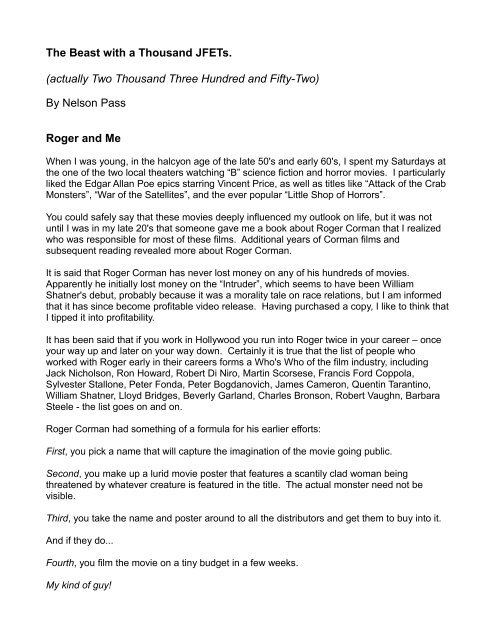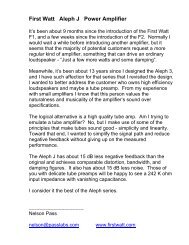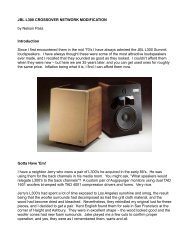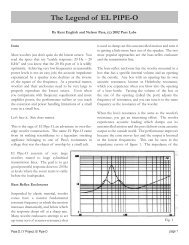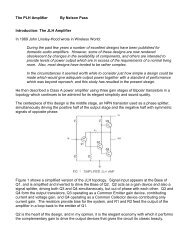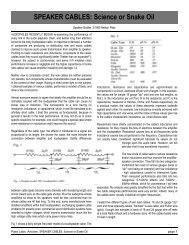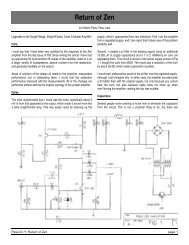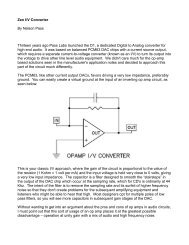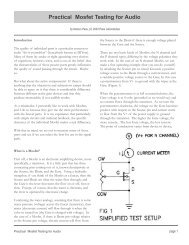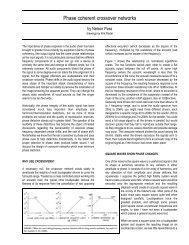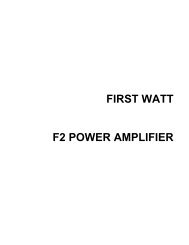The Beast with a Thousand JFETs. (actually Two ... - First Watt
The Beast with a Thousand JFETs. (actually Two ... - First Watt
The Beast with a Thousand JFETs. (actually Two ... - First Watt
You also want an ePaper? Increase the reach of your titles
YUMPU automatically turns print PDFs into web optimized ePapers that Google loves.
<strong>The</strong> <strong>Beast</strong> <strong>with</strong> a <strong>Thousand</strong> <strong>JFETs</strong>.(<strong>actually</strong> <strong>Two</strong> <strong>Thousand</strong> Three Hundred and Fifty-<strong>Two</strong>)By Nelson PassRoger and MeWhen I was young, in the halcyon age of the late 50's and early 60's, I spent my Saturdays atthe one of the two local theaters watching “B” science fiction and horror movies. I particularlyliked the Edgar Allan Poe epics starring Vincent Price, as well as titles like “Attack of the CrabMonsters”, “War of the Satellites”, and the ever popular “Little Shop of Horrors”.You could safely say that these movies deeply influenced my outlook on life, but it was notuntil I was in my late 20's that someone gave me a book about Roger Corman that I realizedwho was responsible for most of these films. Additional years of Corman films andsubsequent reading revealed more about Roger Corman.It is said that Roger Corman has never lost money on any of his hundreds of movies.Apparently he initially lost money on the “Intruder”, which seems to have been WilliamShatner's debut, probably because it was a morality tale on race relations, but I am informedthat it has since become profitable video release. Having purchased a copy, I like to think thatI tipped it into profitability.It has been said that if you work in Hollywood you run into Roger twice in your career – onceyour way up and later on your way down. Certainly it is true that the list of people whoworked <strong>with</strong> Roger early in their careers forms a Who's Who of the film industry, includingJack Nicholson, Ron Howard, Robert Di Niro, Martin Scorsese, Francis Ford Coppola,Sylvester Stallone, Peter Fonda, Peter Bogdanovich, James Cameron, Quentin Tarantino,William Shatner, Lloyd Bridges, Beverly Garland, Charles Bronson, Robert Vaughn, BarbaraSteele - the list goes on and on.Roger Corman had something of a formula for his earlier efforts:<strong>First</strong>, you pick a name that will capture the imagination of the movie going public.Second, you make up a lurid movie poster that features a scantily clad woman beingthreatened by whatever creature is featured in the title. <strong>The</strong> actual monster need not bevisible.Third, you take the name and poster around to all the distributors and get them to buy into it.And if they do...Fourth, you film the movie on a tiny budget in a few weeks.My kind of guy!
One day in 1999 my wife Jill and I were talking about “who would you pick to have dinner <strong>with</strong>if you could”, and my choice was Roger Corman. Without my knowledge, Jill got my attorneyto write a nice letter to his movie company explaining that I was not a stalker, rather a devoutfan warped by a lifetime's exposure to his work, and the ultimate result was an invitation tolunch. I flew to Hollywood and we met at <strong>The</strong> Grill. For an hour and a half I ate a salad andbasked in the presence of Roger Corman. We mostly talked about movies and our kids andeven amplifiers. At the end he autographed a photo for me and let me buy the lunch. It wasone of the best 1.5 hours I have spent.Recently Roger was awarded an Oscar for his lifetime of work.Now I told you that story so that I can tell you this story:<strong>The</strong> <strong>Two</strong> JfetsFor several decades Toshiba made probably the finest complementary Jfets that you couldbuy - the 2SK170 and 2SJ74. <strong>The</strong>y are very low noise parts, quiet enough to serve asamplification for the lowest output moving coil cartridges. <strong>The</strong>y self-bias at very convenientcurrent levels and they are one of the lowest distortion transistors every made.Being complementary types, they make excellent follower (“buffer”) circuits for audioapplications. Here is an example of such a circuit:An “N” channel Jfet (2SK170) and a “P” channel Jfet (2SJ74) are joined at the Source andGate pins, and the Drains are attached to V+ and V- power supply voltages. <strong>The</strong> relationshipbetween the Gate to Source voltages of the devices determines the current flow through theJfet, and in this case insures that the Source Pins “follow” the input voltage faithfully. <strong>The</strong>input impedance of the Gate pins is extremely high, but the output impedance is quite low,around 20 ohms or so, and so the circuit is a “buffer”. It's voltage gain is unity, and theamplication is purely that of current.
This stage is operated push-pull Class A and has a bias (idle) current of the Idss figure of theJfets. <strong>The</strong> Idss is the current which flows when the Gate and Source of the transistor are atthe same voltage. For 2SJ74 and 2SK170 devices, the Idss range is broken down into 3groups: GR is 2.6 to 6.5 mA, BL is 6 to 12 mA, and V is 10 to 20 mA.<strong>The</strong>se devices have a limited voltage rating, 25 volts for the P channel 2SJ74 and 40 volts forthe N channel 2SK170, and this creates a practical limitation for the rail voltages in this pushpull circuit of about 12 volts or so. <strong>The</strong>y also have a limited dissipation rating in free air, 0.40watts.<strong>The</strong>re are some practical additions to the circuit above in the form of three resistors:R1 and R2 inserted in series <strong>with</strong> the Source pins of the Jfets helps to set the current at aslightly lower desirable value than Idss and provides a convenient place to measure thecurrent and adjust the DC offset when the Idss values of the N and P devices are not perfectlymatched.Jfets are sufficiently fast that you can encounter problems <strong>with</strong> parasitic oscillation unless youtake some steps to “damp out” potential RF energy. Resistor R3 accomplishes this.You will perhaps notice that I have specified actual supply rail voltages – those of two carbatteries. You might want to power this up <strong>with</strong> standard lead-acid cell car batteries (youwouldn't be the first one to do so) and also you can find cheap commercial supplies <strong>with</strong> highcurrent ratings at this voltage.
And here's what the board looks like a little closer up:Yes, it's massively parallel.A pair of these amplifiers requires 2352 of these Toshiba Jfets. As they are discontinued andtherefore precious, it is doubly crazy to devote this quantity of these parts. Here is anoverview of the arrangement of the cells:I apologize that the details are somewhat tiny. Muuuuu Hahahahahaaaaa.....
Here is a picture of the patient and multi-talented Roth Wiedrick assembling the channels:Roth tested the Idss of each Jfet and soldered them into the boards:
Roth also made some nice enclosures out of solid red oak.I told you he was multi-talented...What you can't see is that there are two boards to each box, one on each side. <strong>The</strong> powersupplies are external, and the input is via balanced XLR connectors.What you might be able to make out is that the front and rear edges of the circuit boardscontain large numbers of capacitors in parallel to ensure that the power supply impedanceremains low at all frequencies. This is a very fast circuit, and it is not very tolerant ofinductance in the supply (which is remote).<strong>The</strong> bias current of each channel comes out around 5 amps, and we expect the amplifier toleave Class A around 6 amps output (peak), which is more than enough for Class A operationat full power into 4 ohm loads, and about 70 watt peaks into 2 ohms. We get a little moreClass A region than usual due to the square law character of the devices, the transconductanceof the Jfets being somewhat dominant over the 10 ohm Source resistors.<strong>The</strong> amplifiers do dissipate about 140 watts per channel, and you can clearly feel the heatradiating off of the sides. <strong>The</strong> individual devices are running at about 130 milliwatts, wellbelow their rating, and I have not encountered any difficulty <strong>with</strong> reliability since firing them upnearly two years ago.
Measured Performance<strong>The</strong> ordinary objective performance of the amplifier is quite good.<strong>The</strong> bandwidth extends from DC to about 1 megaHertz, and the character of the performanceis consistent very much beyond the audio band. <strong>The</strong> output impedance is about 0.2 ohms sothe damping factor is about 40. <strong>The</strong> noise is at the bottom of the resolution of my test setup.Here are some curves, starting <strong>with</strong> power into 8 ohms:Note that the amplifier was driven by an Audio Precision System 1, whose maximum output isa little under 14 volts rms. Routinely the amplifier can do a few volts more, but that's just icingon the cake.Here is the distortion into 4 ohms:
Finally, here is the distortion into 2 ohms. At this point you can see the amplifier starting topoop out at about 70 watts into 2 ohms, which is about 8 amp peaks, more than expected.Here is what the waveform distortion looks like. Due to the strong symmetry of the circuit, it isthe expected third harmonic at a little more than .002%, and you will note the absence ofvisible higher harmonic orders:That same test at 20 Khz <strong>with</strong> the same amount of distortion.
Here is the frequency response driven by a low impedance source.A word about input capacitance. <strong>The</strong> Jfet pairs here have an input capacitance of about 38pF, and as you start paralleling them up, you multiply this value, Fortunately, runningbalanced results in halving the ultimate values, but in the end the two 294 pair in series worksout to about 5.5 nF capacitance as an input, or about 5 times the old IHF standard.If you wish to get the performance presented, a 50 ohm source will get you about 600 Khzbandwidth, but a 600 ohm source will roll off at 50 Khz. I run about 100 or 200 ohm sources,so I don't have much problem <strong>with</strong> this, however I did consider the possibility that this wouldnot be acceptable to someone (isn't that always the case?).So I provisioned the circuit board so that first cell of each rank of 21 Jfet pairs can be set upas a driver to the remaining 20 simply by strapping that section accordingly. This way theinput capacitance is reduce by a factor of about 20, down to around 250 pF, and allowing for a1 megahertz band<strong>with</strong> <strong>with</strong> a 600 ohm balanced source.<strong>The</strong> same people who might complain about the capacitance might also complain about theadded complexity of drivers. Well, you can't have it all. I have listened to and measured itboth ways, and I find it comes out about the same.<strong>The</strong> Sublime and the RidiculousBesides the fun of the raw craziness of such an amplifier, what's the point? <strong>The</strong> point is tobuild a simple amplifier <strong>with</strong> exquisitely good raw performance and see what it sounds like.Will it open up new vistas of audio experience, polishing out the last smudges on ourwindows of perception?Or will it un-involving and clinical like so many ultra-low distortion efforts we have seen in thepast?I'm inclined toward the former.
I've listened to the amplifier over the last couple years <strong>with</strong> XP10, XP20, and XP30 balancedpreamps and also directly driven by a Wadia 16. <strong>The</strong> loudspeakers have included SR-1's,SR-2's, Lowther PM6a and Feastrex D9nf (both open baffle), Zu Essence, Tannoy HPD 15's,and of course my JBL L300's. Source material has been Vinyl, CD, and 24 bit.From the measurements and looking at the waveforms I had some preconceived notionsabout what to expect, but I was a little surprised. Usually amplifiers <strong>with</strong> so little distortion area little dry and shall we say, “accurate”, and at the same time, my experience is that typicallypure third harmonic character tends to be more dynamic sounding than a second or mixedharmonic tonality.This amplifier is a little less dynamic than most third harmonic pieces, possibly from the lackof feedback, but it is not dry. If it were a wine, I think of it as maybe a light auslese riesling, ascontrasted <strong>with</strong> the fat red cabernets that I like to receive from DIYers (hint, hint).It's very slightly sweet, which is pleasantly surprising, and it has great clarity, letting a lot ofdepth and detail through <strong>with</strong>out any hint of aggressive qualities. Where the sweetnesscomes from, I don't know.Mostly though, the amplifier is not there. At night, <strong>with</strong>out an “on” light, it's really not there.ConclusionRoger Corman turns 87 on April 5. I and many others will take a moment to appreciate hiscontributions to our culture. Here is an older photo displaying his dedication to his work.
What of the future?I think I need an amplifier based on this poster:© 2013 Nelson Pass


